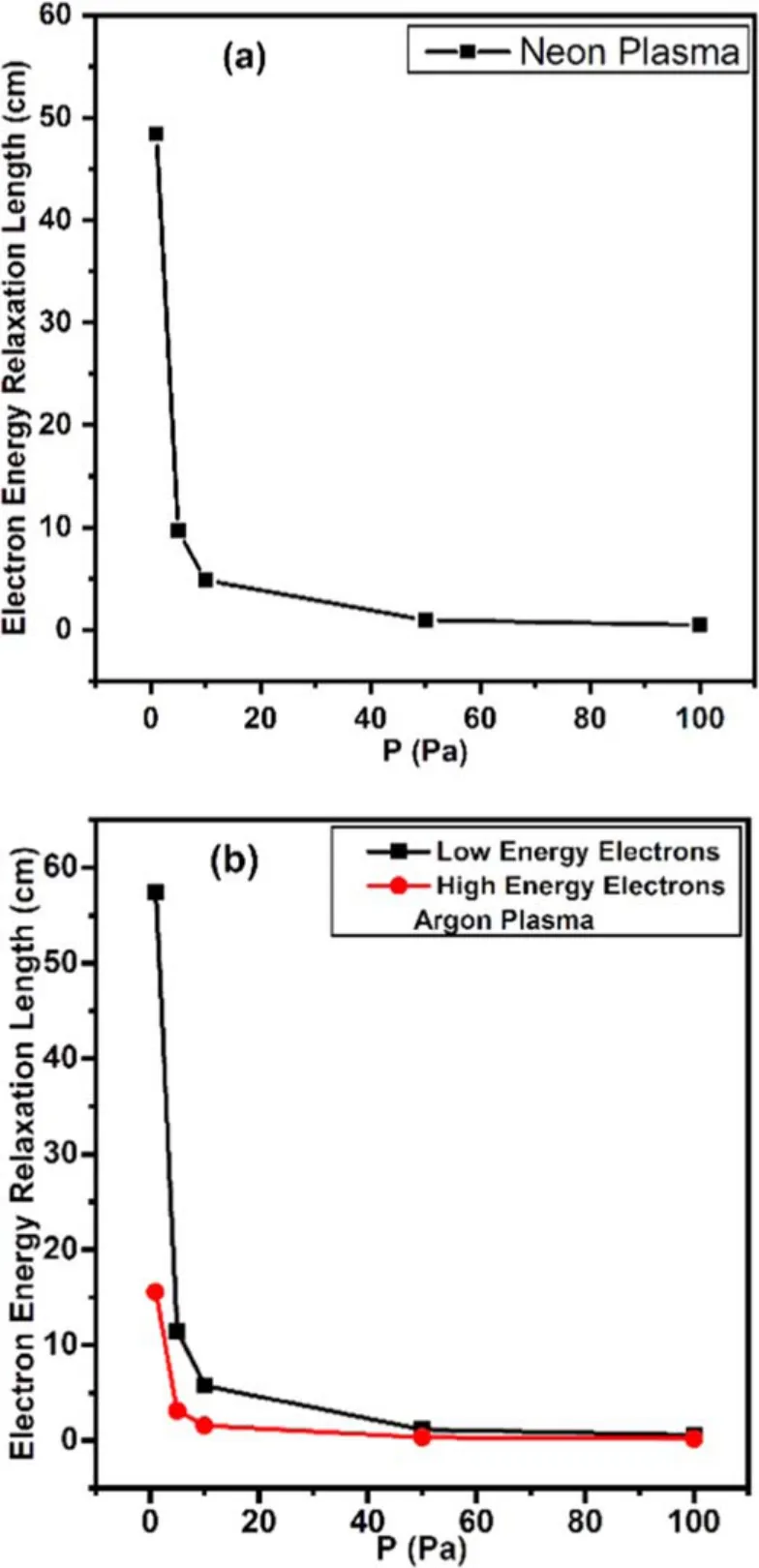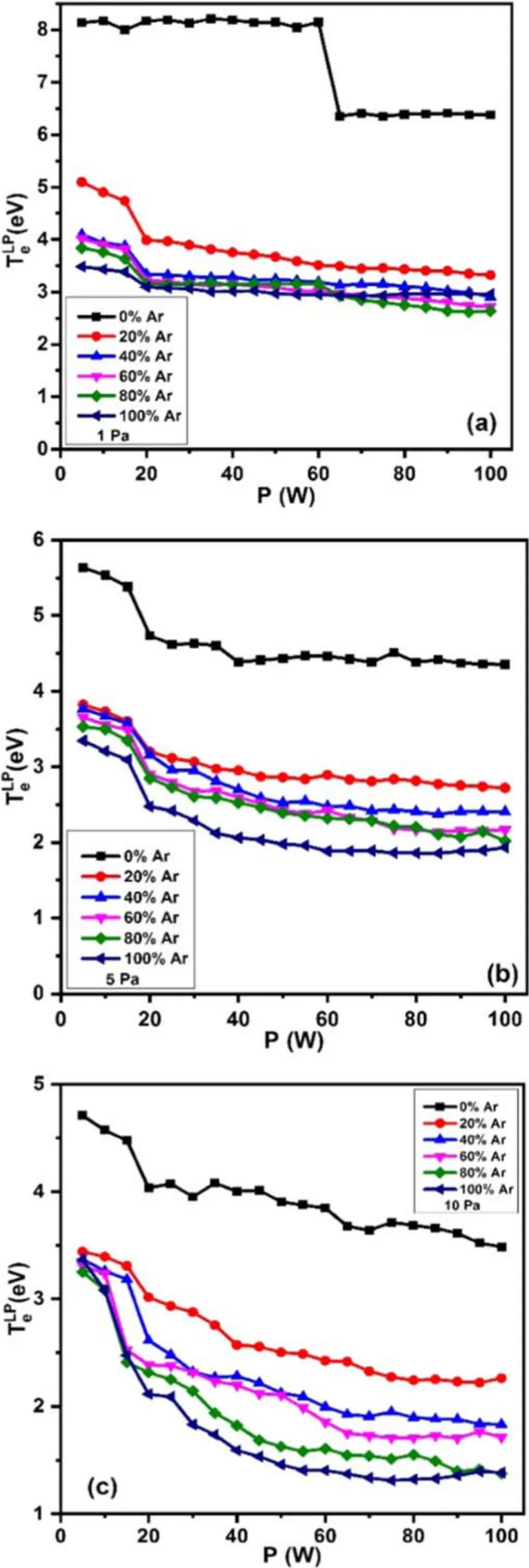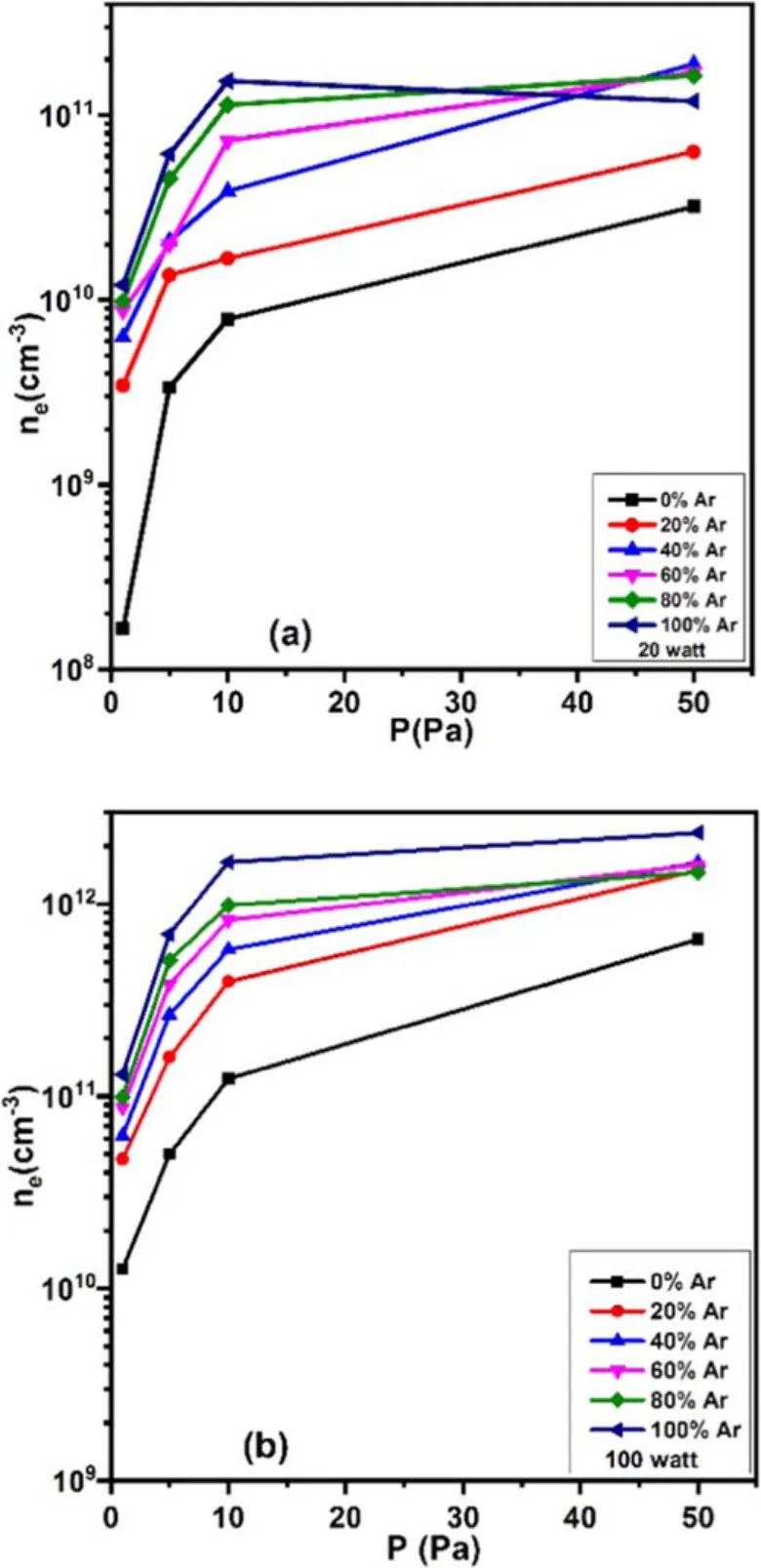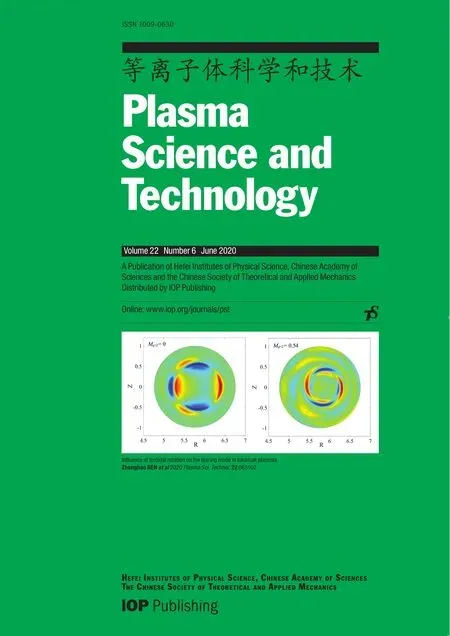Investigation of E–H mode transition in magnetic-pole-enhanced inductively coupled neon–argon mixture plasma
Zahid Iqbal KHATTAK, Abdul Waheed KHAN, Faiq JAN and Muhammad SHAFIQ
1 Department of Physics, Quaid-i-Azam University, 45320 Islamabad, Pakistan
2 Department of Physics, Gomal University, 29050 D. I. Khan, Pakistan
3 Department of Physics, Govt. Post Graduate College Nowshera, 24100 Nowshera, Pakistan
Abstract In this paper,E–H mode transition in magnetic-pole-enhanced inductively coupled neon–argon mixture plasma is investigated in terms of fundamental plasma parameters as a function of argon fraction (0%–100%), operating pressure (1 Pa, 5 Pa, 10 Pa and 50 Pa), and radio frequency (RF) power (5–100 W). An RF compensated Langmuir probe and optical emission spectroscopy are used for the diagnostics of the plasma under study. Owing to the lower ionization potential and higher collision cross-section of argon, when its fraction in the discharge is increased, the mode transition occurs at lower RF power; i.e. for 0% argon and 1 Pa pressure,the threshold power of the E–H mode transition is 65 W,which reduces to 20 W when the argon fraction is increased.The electron density increases with the argon fraction at a fixed pressure, whereas the temperature decreases with the argon fraction. The relaxation length of the low-energy electrons increases, and decreases for high-energy electrons with argon fraction, due to the Ramseur effect. However, the relaxation length of both groups of electrons decreases with pressure due to reduction in the mean free path. The electron energy probability function (EEPF) profiles are non-Maxwellian in E-mode, attributable to the nonlocal electron kinetics in this mode;however,they evolve to Maxwellian distribution when the discharge transforms to H-mode due to lower electron temperature and higher electron density in H-mode.The tail of the measured EEPFs is found to deplete in both E-and H-modes when the argon fraction in the discharge is increased, because argon has a much lower excitation potential (11.5 eV) than neon (16.6 eV).
Keywords: Ne–Ar MaPE-ICP, Langmuir probe, OES, electron temperature, electron density,mode transition(Some figures may appear in colour only in the online journal)
1. Introduction
A mixture of gas discharges comprising noble gases has been frequently investigated to enhance the efficiency of both lower and higher pressure (atmospheric) discharges in various technological and scientific applications,such as the sterilization of medical instruments[1–3],metallic surface nitriding[4–6]and chemical analysis [7]. Material processing with plasma discharges is usually performed by using a combination of various gases simultaneously. For instance, in the etching process of silicon dioxide,discharges of numerous fluorocarbon gases are used with Ar, Xe or H2contents to improve the etching selectivity to the silicon underlayer [8]. Ne–Xe discharges are used for high lighting intensity and easy breakdown in plasma display panels (PDPs). However, PDPs face a significant challenge in the composition of mixed gases in which neon is present [9]. Another instance of mixture discharge that has been explored is the behavior of plasma parameters such as the electron energy distribution function(EEDF) of a high-energy tail, through accumulation of noble gases by means of a trace rare gas technique [10]. Many researchers have explored the mixing gas effect on plasma parameters. For instance, Monuz et al[11]studied the Ar–Ne discharge at atmospheric pressure in a microwave system, they reported the variation in gas temperature, since this temperature is associated with the energy of the heavy plasma species. Rehman et al [12]investigated plasma parameter variation with neon percentage,radio frequency (RF) power, and the pressure of feed gas. It was reported that,as the neon content in the mixture increases,the electron temperature also grows and the EEDF tail gains height and expands towards higher energy.The features of the H-mode and hybrid mode of Ar–N2mixture discharges in magnetic-pole-enhanced inductively coupled plasma (MaPEICP)is discussed by Jan et al[13]through an RF compensated single Langmuir probe (LP). They reported that, as N2concentration and pressure are increased, the critical power required to sustain H-mode is enhanced,and for pure nitrogen discharge this increase is more prominent at higher pressures.Ma et al [14] analyzed the influence of the addition of noble gases on various parameters of nitrogen discharges. It is reported thatTedepends on the variation of gas composition in N2/Ar and N2/He plasmas.
Plasma sources established at various electromagnetic power coupling mechanisms have been introduced for the manufacturing of large-scale semiconductors. Among these,capacitively coupled plasmas (CCPs) as well as very highfrequency CCPs (VHF-CCPs), inductively coupled plasmas(ICPs)and plasmas with a ferrite core have been the leading generation sources investigated [15, 16]. However, the MaPE-ICP is a new and an innovative source, which offers many advantages such as high and uniform density of plasma with great area capability, enhanced power coupling efficiency and a lower electron temperature. This source is therefore potentially more appropriate for material processing[17].The key feature of ICP/MaPE-ICP is its operation in two distinctive (E- and H-) modes, based on external plasma conditions, for instance input power and filling pressure[18–20],and gas composition[21].In recent years,many studies have been performed in the two modes of the ICP/MaPE-ICP, due to the attractive characteristics of the discharge and the underlying physics. Lee [22] performed a comprehensive review of the current knowledge of mode transition and hysteresis of ICPs, their basic understanding,and the application of ICPs in various fields. Gao et al [23]investigated Ar discharges experimentally in ICP configuration and observed a hysteresis loop during the mode transitions from E- to H-mode at several matching conditions. Jing Xu et al [24] investigatedH2-ICP at various pressures and reported the characteristics of the hysteresis loop and mode transition behavior by changing the capacitance of the series capacitor of the matching box. Liu et al
[25] studied mode transitions (from E to H) by using a hairpin probe and optical emission spectroscopy (OES) in CF4/ Ar -ICP. It was observed thatneand the intensity of emission lines are continuously enhanced during E- to H-mode transition at low pressure, whereas at higher pressure, they jump up discontinuously. Gao et al [26] investigated the variation in electron dynamics ofH2RF-ICP discharges with the help of an intensified charged coupled device (ICCD) and a hairpin probe. It was reported thatne,emission intensity, and applied current jump up intermittently. It was also found that at E–H mode transition points,the external voltage jumps down,whereas a decrease in threshold power for the mode transition happened with an increase of pressure. Gao et al [27] also studied theneand emission intensity of the Ar–ICP discharge during mode transition by employing LP and ICCD.It was reported that in the E-mode,neis low and emission intensity is weak,however,bothneand emission intensity are higher when the discharge switches to H-mode. Lee et al [21] analyzed the mode transition of O2/Ar and N2/Ar ICP at low pressure by employing an LP and OES.It was reported that the threshold power for transition was reduced with pressure and argon content. Lee et al [28] investigated the mode transition with a gas mixing ratio in an ICP ofAr / O2/N2mixture discharges. It was reported that the threshold power for mode transition (from E to H) was lower for a smaller ratio of molecular gases and a high ratio of rare gases.
The EEDFs are a consequence of the electric field interaction with plasma and resultantly describe the electron kinetics in the discharge. Therefore, the investigation of EEDFs becomes significant, since it provides information on energy transmission mechanisms such as electron heating in the discharge [29, 30]. Bang et al [31] inspected the characteristics of EEDFs with helium proportion in Ar–He ICP discharges. It is reported that when the helium fraction increases, the EEDFs transform from Druyvesteyn-type to a bi-Maxwellian distribution. Han et al [32] examined the characteristics of EEDFs with helium proportion in Ar–He discharges at a constant pressure of 5 mTorr,and observed that the EEDFs transformed from bi-Maxwellian to Maxwellian and finally became a Druyvesteyn-type distribution.
Even though numerous reports have been published on inert gas discharges, the effects of gas mixing on the threshold power of mode transition, and the evolution of EEPF close to the transition region in the low and high pressure range of rare gases, such as Ne–Ar MaPE-ICP discharges, have not been frequently investigated. The results show interesting behavior in the E-mode and in the transition region of the discharge. The characteristics of the plasma parameters and EEPFs in all the three regions reported are of importance for identifying the working region for applications. Spectroscopic results supported the electrical probe data to a greater extent and showed that an OES investigation is a robust technique to understand discharge behavior. The evolution of EEPFs with argon fraction variation is also included for a better understanding of the three discharge regions.




Figure 2. Relaxation length of low- and high-energy electrons with argon contents in the mixture at (a) 1 Pa, (b) 5 Pa, and (c) 10 Pa.

Figure 3.Variation of electron energy relaxation length with pressure for (a) neon discharge and (b) argon discharge.
Thenevariation versus Ar fraction is shown in figure 6 for various RF powers at constant pressure. An increasing trend of density is observed with Ar fraction.This may be due to the difference in the metastable density of the two gases.The metastable density of Ne atoms seems to be smaller than the Ar atoms, because high-energy electrons are needed to populate the metastable levels of Ne (~16.60 eV), compared to the Ar metastable level (~11.50 eV). So, the Ne atom ionization is less probable from the metastable level and fundamentally, electrons come from the ionization of Ar.When Ar is added to the discharge, however, the relaxation length of high-energy electronsλε,H( ) available in the discharge decreases,as shown in figure 2,and these high-energy electrons encounter inelastic collisions with neutral particles and ionize them. Consequently the electron density increases with Ar fraction. These circumstances produce a partial reduction of the high-energy tail of the EEPFs, which directs to a smaller population of the Ne metastable level, and accordingly electron density increases [11].This may also be explained as follows: whenever a gas of lower ionization energy, for instance Ar, is introduced in a gas of higher ionization energy such as Ne, then the ionization process of neutral Ar atoms enhances owing to the collision of highenergy electrons present in the discharge; as a result electron density increases and electron temperature decreases [8], as shown in figures 6 and 7. The variation ofneandTewith pressure is expressed in figures 8 and 9, at constant Ar fraction and RF power. The decrease in electron temperature can be related to the increase in electron density with pressure.

Figure 4. E–H mode transition in ne with RF power for various argon fractions at pressure of (a) 1 Pa, (b) 5 Pa and (c) 10 Pa.

Figure 5.Variation of TeLP with RF power for different argon fractions at pressure of (a) 1 Pa, (b) 5 Pa and (c) 10 Pa.

Figure 6.Variation of ne with argon fraction for different RF powers at pressure of (a) 1 Pa, (b) 5 Pa and (c) 10 Pa.
The Ne emission line585.24 nm,which arises due to the transition of 2p1→1s2(in Paschen’s notation)involves highenergy electrons. Figure 10 describes the variation of Ne emission line (5 85.24 nm) intensity with increase in RF power and Ar fraction at the pressure of 1 and 5 Pa. The emission intensity shows an increasing trend similar to theneas revealed in figure 4, because the ionization/excitation process enhances with the increase of power.The presence of E- and H-modes is also obvious from the intensity graph. In E-mode,the intensity is low,while in H-mode,the intensity is high and continuously increasing with RF power.

Figure 7.Variation of electron temperature with argon fraction for different RF powers at pressure of (a) 1 Pa, (b) 5 Pa and (c) 10 Pa.
Figures 11 and 12 describe the measured EEPFs’profile close to the transition region as a function of the Ar fraction for different gas pressures of 1, 5 and 10 Pa. In E-mode, the EEPFs exhibit non-Maxwellian characteristics,however,the EEPFs describe the Maxwellian distribution in H-mode.

Figure 8.Variation of ne with pressure for different argon fractions at RF power of (a) 20 W and (b) 100 W.
Figure 11(a) shows that the EEPF profiles of discharge in E-mode are bi-Maxwellian,which is a distinctive property of the nonlocal electron kinetics of plasma at low-pressure[39]. The electron–neutral collision frequency (ν-en) at lower pressure is much smaller than the driving frequency(ωRF) of the source. Generally, nearby the antenna coil,collision-less heating of electrons by the skin layer is dominant. The high-energy electrons penetrate the ambipolar potential barrier and reach the skin layer where further enhancement in their energies takes place and contributes to inelastic collisions. However, low-energy electrons cannot access the sheath layer where the collision-less heating of electrons takes place. Similarly, these electrons cannot contribute in the collisional heating where electrons gain energy from thermalization of electron–neutral collisions.Thus,these electrons absorb a slight quantity of energy from either collisional or collision-less heating and just fluctuate in the barrier of the ambipolar potential [40]. The EEPF transition from bi-Maxwellian to Druyvesteyn distribution in E-mode at a pressure of 5 and 10 Pa takes place as shown in figures 11(b)and(c).At higher pressure,the EEPF transition to Druyvesteyn behavior is owing to the transformation in the heating mechanism of electrons (from stochastic to Ohmic heating). This distribution is mainly due to effective heating of low-energy electrons in the collisional regime [41].
The EEPFs exhibit Maxwellian distribution in H-mode for all the pressures tested, as shown in figures 12(a)–(c).This may be attributed to the way in which, with RF power and Ar fraction, the density enhances and electron–electron collision frequency increases. As a result, the EEPF profiles become Maxwellian. However, when the Ar fraction increases, the high-energy tail of the EEPF is depleted.This may be due to the increase in the Ar fraction providing large energy relaxation lengthλε,L( ) for low-energy electrons due to Ramsauer effects, as shown in figure 2. The Ar ionization energy(15.7 eV)is less than that of Ne(21.5 eV),therefore, the inelastic collisions of high-energy electrons present in the discharge take place with Ar atoms and ionize them. Consequently, the high-energy tail of EEPFs is depleted whereas the density of low-energy electrons is enhanced.
5. Conclusions
In this article, E–H mode transition and the evolution of EEPFs close to the transition region (E- and H-modes) are reported in a mixture of Ne–Ar plasma for numerous RF powers, gas pressures and Ar fractions. Various plasma parameters such as electron density,electron temperature,and emission intensity variation have been studied by using an RF compensated single Langmuir probe and OES. It is observed that, at fixed pressure and Ar fraction, the electron density grows while the electron temperature shrinks with RF power.It is also perceived that the mode transition power is reduced with the increase of Ar fraction in the mixture because RF power coupling efficiency increases with increase in electron density. It is found that electron density of pure Ne is 1.13 × 108cm-3, which increases with Ar fraction and reaches up to1.35 × 1012cm-3in pure Ar discharge, while the electron temperature of pure Ne is 8.14 eV which decreases to0.57 eV in pure Ar at a fixed RF power and gas pressure. It is also found that the intensity of Ne585.24 nm emission line increases with RF power at a constant pressure.However, the intensity in H-mode is greater than E-mode,which is in good agreement with the theoretical concept of E–H mode.The behavior of electron energy relaxation length(λε) is also studied with variation of Ar fraction in the discharge and gas pressure. For low-energy electrons,λε,Lincreases,while for high–energy electrons,λε,Hdecreases with Ar fraction.However,the relaxation length of both the groups of electrons decreases with pressure. The evolution of the measured EEPFs with Ar fraction is also included for a better understanding of the three discharge regions. It is observed that, at fixed RF power and pressure, the EEPFs exhibit non-Maxwellian characteristics in E-mode with Ar fraction, while in H-mode(close to the transition region)Maxwellian behavior is observed. However, in both modes, the tails of EEPFs are depleted when the Ar fraction in the discharge is increased,because it provides a large mean free path for low-energy electrons to gain energy, and the excitation/ionization process is enhanced.Consequently,the density of low-energy electrons is increased, whereas the density of high-energy electrons is depleted. Spectroscopic results are found to be in good agreement with the electrical probe analysis to a significant extent,showing that OES can be employed to assist the probe results and understand the discharge behavior more clearly.

Figure 9. Variation of with pressure for various argon fractions at RF power of (a) 20 W and (b) 100 W.

Figure 10.Emission intensity variation of 585.24 nm line with RF power for various argon fractions at a pressure of (a) 1 Pa and (b) 5 Pa.

Figure 11.Evolution of EEPF in E-mode of discharge with argon fraction at a fixed RF power of 10 W and pressure of(a)1 Pa,(b)5 Pa and(c) 10 Pa.

Figure 12.Evolution of EEPF in H-mode of discharge with argon fraction at a fixed RF power and pressure of(a)1 Pa,(b)5 Pa and(c)10 Pa.
Acknowledgments
This work is partially supported by Quaid-i-Azam University URF for the year 2019–2020 and Higher Education Commission (HEC) P. No. 820 for Plasma Physics Gomal University (D I Khan).
 Plasma Science and Technology2020年6期
Plasma Science and Technology2020年6期
- Plasma Science and Technology的其它文章
- Sensitivity of two drug-resistant bacteria to low-temperature air plasma in catheterassociated urinary tract infections under different environments
- First experimental results of intrinsic torque on EAST
- Gas pressure effect on plasma transport in a magnetic-filtered radio-frequency plasma source
- Design of a variable frequency comb reflectometer system for the ASDEX Upgrade tokamak
- Optimization of plasma-processed air (PPA)inactivation of Escherichia coli in button mushrooms for extending the shelf life by response surface methodology
- Reconstruction of hollow areas in density profiles from frequency swept reflectometry
